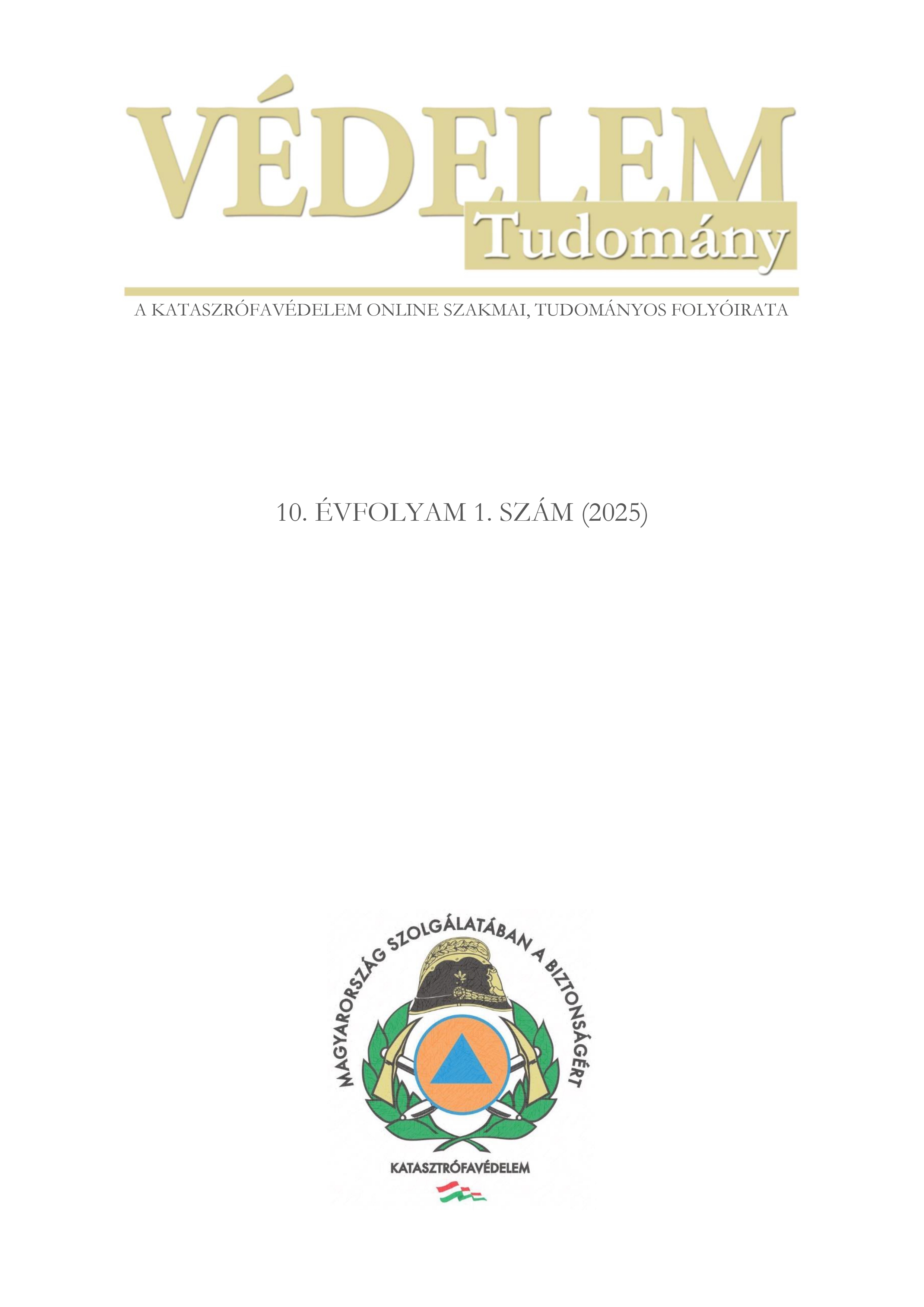Innováció a veszélyhelyzeti oktatásban, a VR technológia használati lehetőségei
Absztrakt
A jövő útja, hogy a veszélyhelyzeti ismeretek oktatásában is teret hódít az Információs és Kommunikációs technológiák a használata, sőt az sem mindegy, hogy az adott ismeretanyag milyen programmal közvetíthető. Mást igényelegy gyakorlás, egy ismeretbővítés, egy-egy probléma megoldása vagy a szimulációs gyakorlat, esetleg egy, a játék bevonásával szervezett oktatási forma. Egyre több jelenik meg ezekből az eszközökből és szoftverekből, programokból a piacon, közülük az alkalmazandók kiválasztása a felkészítő szabadsága. Nem hagyhatjuk figyelmen kívül azonban a generációk sajátosságait és a tanuláselméletek eredményeit sem. A technológiák fejlődésére és az új kihívásokra vonatkozóan megfelelő válaszokkal kell készülnünk a katasztrófavédelmi felkészítések során is. Az oktatás területén egyre nagyobb létjogosultságot követelő digitális technológiák közül ki kell emelni a VR az AR az MR és az XR-szimulátorokat. A virtuális technológiák rugalmas helyzetgyakorlatokkal segítik a tapasztalati alapon történő tanulást és azonnali visszajelzést, továbbá gyorsabb és tartósabb a bevésődés is biztosítanak, mint a hagyományos oktatás. A modern technológiák, köztük a VR eszközök kihívást jelentenek a felkészítők számára, de számos új lehetőséget kínálnak az oktatás terén, melyek lehetővé teszik a tanulóknak, hogy mélyebb és interaktívabb tanulási élményeket szerezzenek, a pedagógusok, felkészítők pedig sikerélményhez jussanak a munkájuk eredményessége láttán. Ezen technológiák integrálásával az oktatási intézmények személyre szabottabb és érdekesebb tanulási környezetet hozhatnak létre diákjaik számára a veszélyhelyzeti ismeretek oktatásában is.
Hivatkozások
Kovács G., Hornyacsek J. „Korszerű oktatási eszközök és módszerek alkalmazása a polgári védelmi felkészítésben.” Katonai Műszaki Közlöny, 29. évfolyam 2. szám pp. 117–132. DOI: 10.32562/mkk.2019.2, 2019. [Online]. Elérhetőség: https://folyoirat.ludovika.hu/index.php/mkk/issue/view/34/MKK%202019-2 (2025.06.27.)
M. Prensky, Digital wisdom and homo sapiens digital. Deconstructing digital natives. Routledge, 1. kiadás, 2011. [Online]. Elérhetőség: https://www.taylorfrancis.com/chapters/edit/10.4324/9780203818848-3/digital-wisdom-homo-sapiens-digital-marc-prensky (2025.06.27.)
Információs és Kommunikációs Technológiák [Online] Elérhetőség: http://okt.ektf.hu (2025.06.27.)
Belényesi E., Budaváriné Béres E., Molnár K., Pallai É., Stréhli-Klotz G. „Pedagógiai módszertani ismeretek a közszolgálati pályaorientációs képzés oktatói számára”, Nemzeti Közszolgálati Egyetem, Dialóg Campus, Budapest, [Online]. Elérhetőség: https://fejlesztesiprogramok.uni-nke.hu/document/fejlesztesiprogramok-uni-nke-hu/Kozig_Palyaorientacio_B5_VEGL_jav.pdf (2024.03.16.)
Pacsi D., Szabó Z. „A gamifikáció fejlődése és a magyar gamifikációs trend alakulása” Studia Mundi–Economica, pp. 57-68, 2017. [Online]. Elérhetőség: https://journal.uni-mate.hu/index.php/stm/article/view/3181/3561 (2025.06.27.)
Nagy L. „Digitális lelkek, avagy hogyan fejlesszük a Z és Alfa generációt? IKT kompetenciafejlesztés a középiskolában és a tanárképzésben,,” Vizuális kultúra 1/4, pp. 34-37., 2021. [Online]. Elérhetőség: https://vizualiskulturaujsag.hu/wp-content/uploads/2021/07/2.%20NagyL.pdf (2025.06.27.)
Gregory. R. L., Az értelmes szem, Budapest: Gondolat, 1973.
Geier J. „Kandidátusi értekezés: Egy komputációs modell a sztereó párosítási probléma megoldására”, Budapest, 1994. [Online]. Elérhetőség: https://www.geier.hu/lila/KANDI/kandip.htm (2025.06.27.)
Wikipedia.org „Charles Wheatstone – mirror stereoscope” [Online]. Available: https://commons.wikimedia.org/w/index.php?curid=9783312 . (2025.06.27.)
Medium.com „Pygmalion’s spectacles: Using Berkeley’s Immaterialism to understand the Potentialé for Telepresence in Virtual Reality” [Online]. Elérhetőség: https://medium.com/@musingsofamariominion/pygmalions-spectacles-using-berkeley-s-immaterialism-to-understand-the-potential-for-telepresence-46b9e46eba42 (2025.06.27.)
HistoryofInformation.com „Antonin Artaud Describes La Réalite Virtuelle” [Online]. Elérhetőség: https://www.historyofinformation.com/detail.php?id=1323 (2025.06.27.)
HistoryofInformation.com „The Sensorama Machine” [Online]. Elérhetőség: https://www.historyofinformation.com/image.php?id=2078 (2025.06.27.)
Immersivearchive.org „The Sensorama” [Online]. Elérhetőség: https://immersivearchive.org/sensorama.html (2025.06.27.)
Virtually There Training „iLightbox” [Online]. Elérhetőség: https://www.virtuallytheretraining.com/more-info/#iLightbox[16867a4d9d945b150e3]/0 (2025.06.27.)
Kovács G. „A védelmi szférában alkalmazható VR alapú kiképzés/felkészítés során felmerülő negatív fizikai és pszichológiai jelenségek.” [Online]. Elérhetőség: https://real.mtak.hu/196389/1/KatLog8.pdf (2025.06.27.)
Sam Sprigg, „Bublar Group partners with Dafo to create Virtual Reality fire emergency training solution.” [Online]. Elérhetőség: https://www.auganix.org/bublar-group-partners-with-dafo-to-create-virtual-reality-fire-emergency-training-solution/ (2025.06.27.)
Juhász L., Pokorádi L. „Kiterjesztett valóság a modern karbantartásban.,” Repüléstudományi közlemények XXX. évfolyam [Online]. Elérhetőség: https://folyoirat.ludovika.hu/index.php/reptudkoz/article/view/4319/3528 2025.06.27.)
Anne-Francoise P. „Carmakers Invest €42.5M in British AR Head-Up Display Startup.” [Online]. Elérhetőség: https://www.eetimes.eu/carmakers-invest-e42-5m-in-british-ar-head-up-display-startup/ (2025.06.27.)
Dr. Rónay P.„AR, MR, VR, XR – négy rövidítés, amit szükséges ismerni a modern UX-UI világban” [Online]. Elérhetőség: https://ergomania.hu/ar-mr-vr-xr-negy-rovidites-amit-szukseges-ismerni-a-modern-ux-ui-vilagaban/ (2025.06.27.)
Dr. Restás Á. „Égés és tűzoltás elmélet egyetemi jegyzet” Budapest: Nemzeti Közszolgálati Egyetem, Katasztrófavédelmi Intézet, 2014.
Flaimsystems.com „Enhance firefighter readiness” [Online]. Elérhetőség: https://flaimsystems.com (2025.06.27.)
Heizenrader „The 3 types of virtual reality” [Online]. Elérhetőség: https://heizenrader.com/the-3-types-of-virtual-reality/ (2025.06.27.)
Etcsimulation.com „Fire Training” [Online]. Elérhetőség: https://www.etcsimulation.com/adms-users-fire.html (2025.06.27.)
James P. B., Philip D. T., Michael A., „The Effectiveness of Virtual Reality for Administering Spatial Navigation Training to Firefighters” Massachusetts: Massachusetts Institute of Technology, 1997
C. Werner „Fire Technology: The Future of Wearable Technology” [Online]. Elérhetőség: https://www.firehouse.com/technology/mobile-technology-accessories/article/21000640/wearable-technology-for-firefighters (2024.03.16.)
Xpertvr.ca „5 reasons to train firefighters in virtual reality” [Online]. Elérhetőség: https://xpertvr.ca/5-reasons-to-train-firefighters-in-virtual-reality/ (2025.06.27.)
Manus-Meta.com „Vr gloves” [Online]. Elérhetőség: https://xpertvr.ca/5-reasons-to-train-firefighters-in-virtual-reality/ (2025.06.27.)
Copyright (c) 2025 Védelem Tudomány a Katasztrófavédelem online szakmai, tudományos folyóirata

This work is licensed under a Creative Commons Attribution-NonCommercial 4.0 International License.




